More about Thimbles





Magdalena and William Isbister.
Two distinct gold thimbles have come to be associated with the names of both a Queen of the Netherlands, Queen Wilhelmina, and a Parisian goldsmith, P. Lenain. One thimble depicts girls in different sewing poses and the other shows the Queen at various stages in her life. Of the former, in 1992, Aardewerk (1) wrote, ‘Unfortunately however, he names ‘P. Lenain & Co.’ of Paris as the maker instead of Duval’. She was speaking of von Hoelle’s incorrect attribution of the ‘Sewing Girls’ thimble to ‘’P. Lenain & Co’’ in ’The Thimble Collector’s Encyclopedia’ (2). The second gold thimble, also described in the paper by Aardewerk, has been attributed to ‘Pierre Lenain’ too (3). In this short paper, we examine the attributions of these two thimbles and attempt to correct a mistake that seems to have been widely accepted by thimble collectors on both sides of the Atlantic Ocean for many years. We will not discuss, in depth, whether either of these thimbles was made for President Kruger of South Africa to give to the Queen as a wedding present, a view supported in the early French literature (4, 5, 6) but strongly contested by many non-French writers (1, 7).
In 1900, Frédéric Charles de Vernon had designed a thimble for his old time colleague and friend the medal maker and jeweller Julien Duval. The thimble was designed to be made in two parts using a flat sheet of either silver or gold. The design was die stamped onto the metal with a special die constructed with the use of a ‘tour à réduire’. The ‘tour à réduire’ machine was used in medal making to vary the size of the die to be used to stamp the final medal. A large wax model of the design was first produced and then by means of a series of wheels and levers the wax image was traced with a fine metal wire and engraved with a needle on the metal die. By adjusting the wheels and levers, the size of the engraved image could be varied so that several different sized dies could be made from the same original wax model. The thimble made by this method was so impressive that it was illustrated in ‘La bijouterie française au XIXe siècle’ (5). Vever stated that President Kruger gave the thimble to Queen Wilhelmina as a wedding present. A year later in April 1909, the French revue ‘Les Modes’ (8) showed a picture of the design with the caption ‘’Développment du ‘dé la reine’ executé par F. Vernon en dépôt chez Henry, à la pensée’’. There was absolutely no information in ‘Les Modes’, however, upon which a link between the thimble either ’P. Lenain & Co’ or ‘Pierre Lenain’, as was done by Holmes (3), could have been based because there was no accompanying text (9). There was only an additional advertisement indicating that the thimble called ‘’Le dé de la reine’’ was available from ‘‘Henry, à la pensée’’ (rue du Faub.-Saint-Honoré in Paris). It cost 20 fr. at the time.
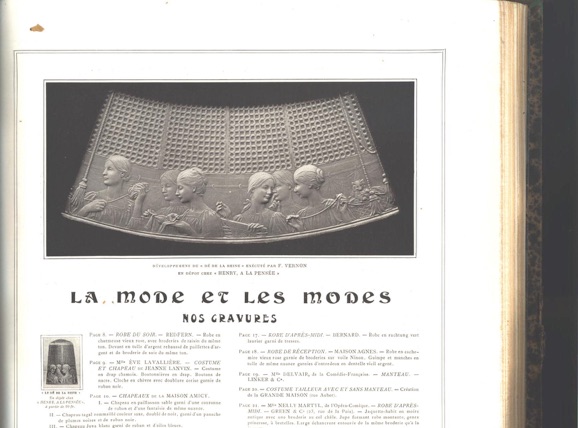
In 1986, in ’’The Thimble Collector’s Encyclopedia’’, von Hoelle reproduced the picture from ‘‘Les Modes’’ (2) and wrote below it that ‘The thimble was made by ‘P. Lenain & Co. of Paris’. It is this attribution to P. Lenain & Co. and not to Julien Duval that is in question and it is difficult to understand the basis for von Hoelle’s conclusion.
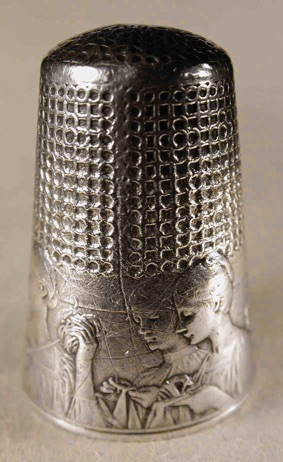
The thimble, known as the ‘Sewing Girls’, depicted a woman winding wool, two ladies doing embroidery, a further lady embroidering with a frame looking over her shoulder to a woman holding a needle and thread. In between these last two ladies are two further ladies. The embroiderer’s frame is signed ‘ F. Vernon’ and the seam is hidden by a curtain sash. There is a kitten playing with wool and for this reason this thimble was called the ‘cat’ thimble by Holmes (3). It was originally made in gold, silver and silver-gilt.
There are two controversies, which have existed in relation to the ‘cat’ thimble. The first relates to whether the thimble was actually a wedding gift to Queen Wilhelmina from President Kruger. This fable has been discredited for ever by Dreesmann who made extensive enquiries at the Royal House Archives of the Netherlands in the 1970s (1,10). It appears that President Kruger did, in fact, give Queen Wilhelmina a wedding present but that it was a silver inkwell and not a gold thimble (10).
The second controversy relates to the suggestion that two goldsmiths made the thimble – P. Lenain & Co. and Julien Duval. This assertion is based on the statement made by von Hoelle (2) who names ‘P. Lenain & Co. of Paris’ as the maker. Von Hoelle was supported by Holmes (3) who wrote ‘’This is not necessarily a mistake.’’ and went on to describe a ‘’German club magazine’’ (11) which ‘’showed a gold ‘cat’ thimble’’ purported to have ‘’been made by Lenain on its front cover’’. Holmes continued ‘’it is conceivable that Duval either leased out the design, or else decided that it was preferable to have a specialised thimble-maker produce the thimbles for them.’’ As a result of this commentary and the German photograph, the concept that two goldsmiths made the ‘cat’ thimble became thimble lore.
It is certainly true that the German magazine’s gold ‘Sewing Girls’ thimble was attributed to ‘P. Lenain & Co.’ and this seems to be the only real evidence to support the contention that ‘P. Lenain & Co.’ actually made the thimble. How robust is this evidence? Firstly, this exact wording appeared in von Hoelle in 1986 and one might wonder whether the von Hoelle mistake (2) was being perpetuated? Alternatively, there might have been a Lenain master’s mark on the thimble in question? In order to answer this question it was necessary to learn more of the thimble depicted in ‘Rund um den Fingerhut’ (11). A clue came from a paper describing some of the thimbles in the collection of the owner of the ‘German’ gold ’Sewing Girls’ thimble. The paper was given to the 2000 TCI convention by Mrs. Andree Lange and the slides depicting the thimble were numbers 66-68:

It is of interest to read that the only mark noted on the thimble in question was that of the petite garantie for Paris of the eagle’s head. There was no mention of a maker’s mark. We decided to delve further and after many letters via friends to the owner of the thimble, we were able to ascertain that there was no clearly legible maker’s mark on the thimble and that the description given at the TCI convention was entirely accurate. There was thus no hard evidence to link the thimble to P. Lenain. It is assumed that this linking took place as a result of the information given in von Hoelle, although von Hoelle did not accurately reflect the quoted ‘Les Modes’ revue. One year later, the picture of the thimble on the cover of the German Magazine was published. Holmes based his writings on this erroneous attribution and further complicated the story.
There remains one further, rather powerful, piece of evidence against P. Lenain & Co. being the makers of the ‘Sewing Girls’ thimble. If ‘P. Lenain & Co.’ had been asked to make the thimble, or Pierre Lenain, as Holmes suggests (3), then it would be expected that the Lenain Company would have had an original die and that when Roger Lenain reissued many silver commemorative thimbles in the 1970s, the ‘Sewing Girls’ thimble would have been one of the reissues. This was not the case. Duval made the thimble, had the die, it never belonged to Lenain and thus could not be reissued. ‘P. Lenain and Co.’ never made the thimble.
We have been unable to find any evidence to support the contention that any ‘Sewing Girls’ thimble has a Lenain mark and so must conclude that there is no evidence to support the suggestion, which has become thimble folklore, that P. Lenain & Co. had anything to do with the manufacture of the Vernon designed Duval made ‘Sewing Girls’ thimble.
The second thimble, also designed by Frédéric Charles de Vernon, was made by Maison A Féau in 1901 to commemorate the wedding of Queen Wilhelmina of the Netherlands. The top and sides were waffle dimpled and the band depicted the Queen playing with a doll as a child, as a maiden doing embroidery and as a grown woman wearing a crown. The royal coat of arms was on the other side of the band (6, 7). The original thimble was made in gold, silver or gilded. A Féau presented a gold version of this thimble to Queen Wilhelmina in 1901 – it is in a special étui in the Royal House Archives (1, 7). This thimble was called the ‘crown’ thimble by Holmes (3); however, Holmes attributed the thimble to Pierre Lenain and not A Féau. This was clearly a mistake and has led to some confusion among thimble collectors.
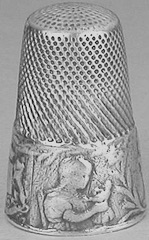
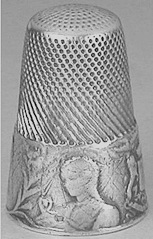
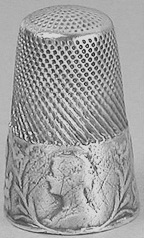
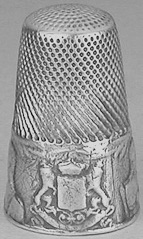
The Maison Féau thimble commemorating the Royal Wedding of Queen Wilhelmina was reissued in the 1970s by Roger Lenain who had purchased the Lorillon – Féau company – ‘Le Dé a Coudre’ in 1964 (12). The reissued thimble was made with the original die but this time only the top of the thimble was dimpled, the sides were plain and polished (7). The reissued thimbles were sold by Mrs. Rosalind Belford (‘Sewing Corner’ and later ‘Collectors Choice’) who also commissioned the 1970s reissues of the de la Fontaine Fable and other thimbles (13) for the American market (personal communication, B Frank).
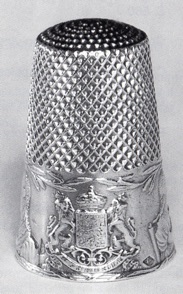
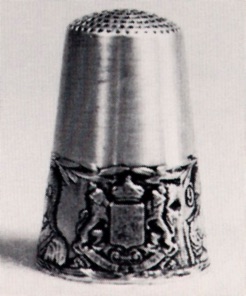
original reissue
Over the years P. Lenain & Co. and Pierre Lenain have come to be associated with these two ‘royal’ thimbles but in fact it was A Féau and not P. Lenain & Co. who made a wedding gift of a thimble to Queen Wilhelmina, and the thimble that was thought, incorrectly, to have been a wedding gift from a South African President to the Queen was not made by P. Lenain & Co. either. There is thus no connection between Queen Wilhelmina and P. Lenain and Co. except in thimble legend. It is time to put this tale to rest once and for all.
Acknowledgements:
We are especially thankful to the people listed below who responded promptly to our many questions:
Madame Ghislaine Chaplier who answered many emails and made direct contact with Monsieur Roger Lenain himself.
Wolf-Dieter Scholz who made his vast library of references available to us.
Michel Painsonneau who shared his knowledge of French thimble making history with us.
Beryl Frank who shared her reference sources.
References:
1. Aardewerk B. The famous Vernon thimble. Thimble Society Magazine, 1992; 4(6): 4.
2.von Hoelle JJ. Thimble collector’s encyclopedia. Illinois: Wallace-Homestead Book Company, 1986. pp. 256.
3. Holmes EF. Thimble Notes and Queries 1992; 17: 13.
4. Robert A. Le De. Revue de la Bijouterie, Joaillerie et Orfèvrerie, January, 1901.
5. Vever H. Paris: H Floury 1908. La bijouterie française au XIXe siècle’. tome lll, pp. 560.
6. Langedijk CA. Das Missverständnis um zwei goldene Fingerhüte. Rund um den Fingerhut, 2001;33: 4.
7. Dreesmann C. A thimble full.… Utrecht/Netherlands: Cambium, 1983. pp.70.
8. Les Modes. Revue mensuelle illustrée des arts décoratifs appliqués à la femme. Paris: Goupil & Cie. 1906, April.
9. van Wijland J, Département des sciences et techniques, Bibliothèque nationale de France.
10. Dreesmann C. Letter to Mr. E Holmes dated 17 January 1978.
11. Rund um den Fingerhut, 1987;.7: cover
12. Crestin-Billet F. Ouvrages de dames. Paris: Tana, 2005. pp. 74-77.
13. Belfford R. French Silver Thimbles. Silver, 1979: July-August: 34.
TCI Bulletin Summer 2007
Holmes: ‘Thimbles in France’ pp. 65.
Researched and published in 2002/11
Copyright@2011. All Rights Reserved
Magdalena and William Isbister, Moosbach, Germany
The story of two ‘Royal’ thimbles
Navigation
